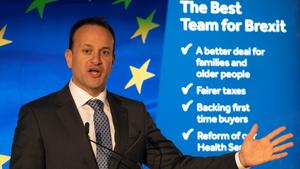 Ireland's Prime Minister, and leader of the Fine Gael party, Leo Varadkar speaks during the launch of the party's General Election manifesto in Dublin on Jan 24, 2020. (Paul Faith / AFP)
Ireland's Prime Minister, and leader of the Fine Gael party, Leo Varadkar speaks during the launch of the party's General Election manifesto in Dublin on Jan 24, 2020. (Paul Faith / AFP)
Irish Prime Minister Leo Varadkar’s party defied pre-election surveys to stay in contention to keep power, as an exit poll showed the nation’s three biggest political parties in a dead heat.
Varadkar’s Fine Gael won 22.4 percent of first-preference votes in Saturday’s election, according to the poll, state broadcaster RTE said, confounding surveys that put the party in third place before the vote.
Sinn Fein won 22.3 percent, according to the Ipsos/MRBI poll of 5,000 voters, commissioned by RTE and the Irish Times. Though Sinn Fein is in the race to be the biggest party by vote share, it didn’t run nearly enough candidates to become the dominant force in Ireland’s 160-seat parliament.
READ MORE: Sinn Fein moves into lead as Varadkar trails before election
Fianna Fail, which oversaw the nation’s international bailout in 2010, secured 22.2 percent in the poll, which has a margin of error of 1.3 percentage points. Counting begins at 9 am on Sunday in Dublin and could run into the middle of the week.
There’ll have to be significant compromise, and rowing back from election commitments, or else Ireland will be voting again this year.
Eoin O’Malley, Professor, Dublin City University
It’s clear no party will come close to a majority, meaning Varadkar and Fianna Fail leader Micheal Martin will have to seek out coalition partners. The party with the most seats will be in prime position to lead the government. The Greens and Labour Party, with a combined 12.5 percent, may become kingmakers.
“The exit poll suggests a great degree of fragmentation, which will make government formation very difficult,” according to Eoin O’Malley, a politics professor at Dublin City University.
“There’ll have to be significant compromise, and rowing back from election commitments, or else Ireland will be voting again this year.”
Under Ireland’s electoral system, about 44 percent is needed for an outright majority.
ALSO READ: Irish farmers fire election warning shot with Dublin tractor protest
The result means Varadkar, 41, still has a fighting chance to stay in power. In the last days of the campaign, Fine Gael unleashed attacks on Fianna Fail’s economic record and questioned the democratic credentials of Sinn Fein, long considered toxic by mainstream politicians for its links to the IRA terrorist group.
Policy Continuity?
A Fine Gael or Fianna Fail-led government “would largely mean continuity from a financial and economic policy perspective,” said Bert Colijn, an economist with ING Groep NV.
 A pedestrian walks past election posters featuring Sinn Fein President Mary Lou McDonald (top), Ireland's Prime Minister and Fine Gael leader Leo Varadkar (center) and the Green Party's Eamon Ryan, in Dublin on Feb 6, 2020 ahead of the Feb 8 general election.
(BEN STANSALL / AFP)
A pedestrian walks past election posters featuring Sinn Fein President Mary Lou McDonald (top), Ireland's Prime Minister and Fine Gael leader Leo Varadkar (center) and the Green Party's Eamon Ryan, in Dublin on Feb 6, 2020 ahead of the Feb 8 general election.
(BEN STANSALL / AFP)
The traditional divide in Irish politics runs between Fine Gael and Fianna Fail, separated by little except where they stood on the division of Ireland in 1921. Both share Brexit policies, broadly agree on economic and fiscal policy and vow to protect the nation’s 12.5 percent corporate tax rate.
Before the election, both Varadkar and Martin ruled out pacts with Sinn Fein, though some members of Fianna Fail say Martin should keep the option open.
“Would he do it?” O’Malley, the political scientist, said before the election. “It’s his last chance to be Taoiseach, so if the numbers add up, probably, yes.”


